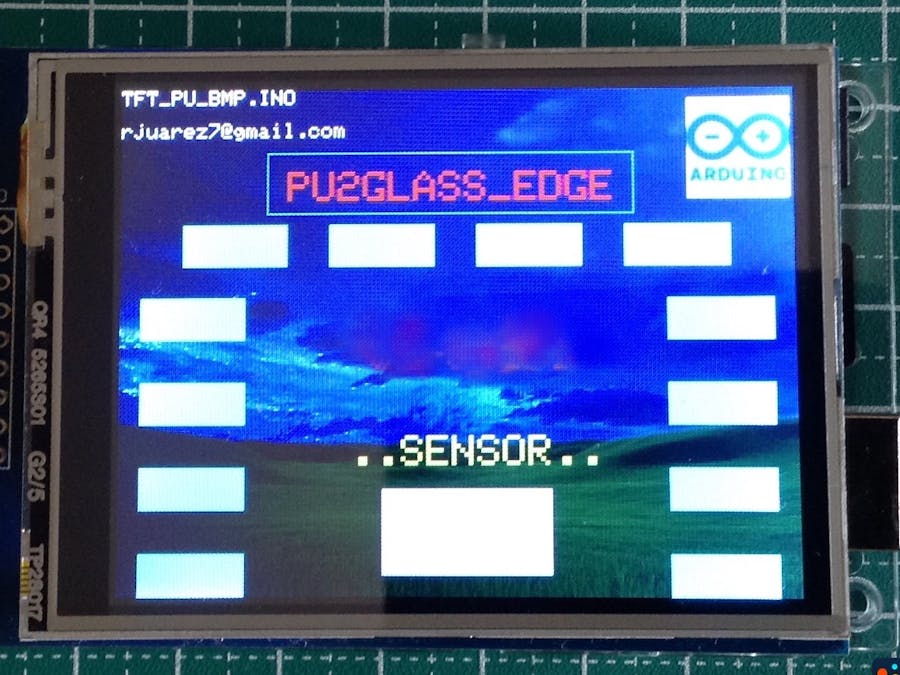I want to create a self guided device for meassuring the poliurethane bead in a winscreen glass before the robot inserts it to the car.
the operator can meassure 4 points per glass side to check if the bead is well located.
this meassurement ican be done before the poliurethane is cured, with out contact. Normal method use a calliper to meassure the bead position once it is cured. The glass must wait 24h before it can be meassure to avoid the bead could be damaged.
with this method the glass can belongs to a production car, it can be measured and inserted again.
due to the TFT has a SD car, the data can be stored on it for data tracking as a control process.
.........................................
If you did like this project you can donate some cents of Crypto currency
Bitcoins SV in the following address.
1sAZQMy5Ci1G88CmbucFJDsF7TxeXAcko
or bitcoin cash in the address:
qzmjpeqrlgd3flltpavm9t2xh0nz8y97mggajvvqnv
or Stellar XLM in the address:
GBAWDPQ4FTRXWE2ZUWVYYZ7XSCQGBYZGOWQMAHSA2FPGJ5QTLF4IJ3NX
thanks
#include <gfxfont.h>
// HACER QUE PINTE UNA VEZ Y HASTA QUE NO DETECTE LA TOUCH NO CAMBIE, O EL PUERTO SERIE
// LIMPIAR EL CDIGO NO USADO
#include "TouchScreen.h"
#include <Adafruit_GFX.h> // Hardware-specific library
#include <Adafruit_TFTLCD.h> // Hardware-specific library
#include <SPI.h>
#include <SD.h>
#define SD_CS 10 // CHIP SELECT CARTA SD DEL TFT
#define LCD_CS A3 // Chip Select goes to Analog 3
#define LCD_CD A2 // Command/Data goes to Analog 2
#define LCD_WR A1 // LCD Write goes to Analog 1
#define LCD_RD A0 // LCD Read goes to Analog 0
#define LCD_RESET A4 // Can alternately just connect to Arduino's reset pin
// Pins for the LCD Shield
#define YP A3 // must be analog
#define XM A2 // must be analog
#define YM 9 // digital or analog pin
#define XP 8 // digital or analog pin
#define MINPRESSURE 1
#define MAXPRESSURE 1000
// Calibration mins and max for raw data when touching edges of screen
#define TS_MINX 210
#define TS_MINY 210
#define TS_MAXX 915
#define TS_MAXY 910
// Assign human-readable names to some common 16-bit color values:
#define BLACK 0x0000
#define BLUE 0x001F
#define BLUE2 0x00FF
#define RED 0xF800
#define GREEN 0x07E0
#define CYAN 0x07FF
#define MAGENTA 0xF81F
#define YELLOW 0xFFE0
#define WHITE 0xFFFF
int sensorPin = A0;
int sensorValue = 0;
float sensorValor=0.00;
Adafruit_TFTLCD tft(LCD_CS, LCD_CD, LCD_WR, LCD_RD, LCD_RESET);
int touchCnt = 0;
int buttonState = 0;
TouchScreen ts = TouchScreen(XP, YP, XM, YM, 300);
uint16_t x = 50, y = 100;
String inputString = ""; // a string to hold incoming data
boolean stringComplete = false; // whether the string is complete
void setup()
{
// put your setup code here, to run once:
uint16_t tmp;
Serial.begin(9600);
// reserve 200 bytes for the inputString:
inputString.reserve(200);
tft.reset();
delay(100);
tft.begin(9600);
uint16_t identifier = tft.readID();
Serial.print("El ID de la placa tft es = 0x");
Serial.println(identifier, HEX);
tft.begin(identifier);
tft.fillScreen(BLACK);
Serial.print(F("Initializing SD card..."));
tft.setRotation(1);
tft.setTextSize(2);
tft.println("ID de la placa tft = 0x");
tft.println(identifier, HEX);
delay(1000);
tft.println("");
tft.println(F("Inicializando carta SD..."));
delay(1500);
if (!SD.begin(SD_CS))
{
tft.println("Error:No puedo acceder a la SD");
return;
}
Serial.println(F("OK!"));
tft.print(F("...."));
delay(500);
tft.println(F(".............."));
tft.println(F(""));
tft.println(F("SD lista!"));
delay(1000);
bmpDraw("4.bmp", 0, 0);
bmpDraw("1.bmp", 270, 5);
pantallaPU();
}
void loop()
{
inputString = "";
}
void pantallaPU()
{
tft.setCursor(0, 0);
tft.setTextSize(1);
tft.println("TFT_PU_BMP.INO");
tft.println(" ");
tft.println("rjuarez7@gmail.com");
delay(500);
//tft.fillScreen(BLACK);
//tft.setRotation(1);
tft.setCursor(80, 40);
tft.drawRect(70, 30, 175,30,BLUE);
tft.setTextSize(2);
tft.setTextColor(RED);
tft.println("PU2GLASS_EDGE");
//WS CD391
// CUADROS LADO SUPERIOR
tft.fillRect(30, 65, 50,20,CYAN);
tft.fillRect(100, 65, 50,20,CYAN);
tft.fillRect(170, 65, 50,20,CYAN);
tft.fillRect(240, 65, 50,20,CYAN);
//CUADROS LADO IZQUIERDO
tft.fillRect(10, 100, 50,20,CYAN);
tft.fillRect(10, 140, 50,20,CYAN);
tft.fillRect(10, 180, 50,20,CYAN);
tft.fillRect(10, 220, 50,20,CYAN);
//CUADROS LADO DERECHO
tft.fillRect(260, 100, 50,20,CYAN);
tft.fillRect(260, 140, 50,20,CYAN);
tft.fillRect(260, 180, 50,20,CYAN);
tft.fillRect(260, 220, 50,20,CYAN);
//TTULO WS CD 391
tft.setCursor(120, 120);
tft.setTextSize(2);
tft.println("WS-CD391");
// FIN PANTALLA WS CD391
//VENTANA SENSOR
tft.setCursor(110, 165);
tft.setTextSize(2);
tft.setTextColor(YELLOW);
tft.println("..SENSOR..");
tft.fillRect(125,190,80,40,WHITE);
tft.setCursor(130, 200);
tft.setTextSize(1);
tft.setTextColor(BLUE);
//FIN SENSOR
//while(p.z < MINPRESSURE)
//delay(1000);
}
void pantalla2()
{
tft.setCursor(0, 0);
tft.setTextSize(1);
tft.println("TFT_PU_BMP.INO");
delay(500);
//tft.fillScreen(BLACK);
//tft.setRotation(1);
tft.setCursor(40, 30);
tft.drawRect(30, 20, 260,30,BLUE);
tft.setTextSize(2);
tft.setTextColor(RED);
tft.println("PU / GLASS EDGE mm");
//WS CD391
// CUADROS LADO SUPERIOR
tft.fillRect(30, 60, 50,20,CYAN);
tft.fillRect(100, 60, 50,20,CYAN);
tft.fillRect(170, 60, 50,20,CYAN);
tft.fillRect(240, 60, 50,20,CYAN);
//CUADROS LADO IZQUIERDO
tft.fillRect(10, 100, 50,20,CYAN);
tft.fillRect(10, 140, 50,20,CYAN);
tft.fillRect(10, 180, 50,20,CYAN);
tft.fillRect(10, 220, 50,20,CYAN);
//CUADROS LADO DERECHO
tft.fillRect(260, 100, 50,20,CYAN);
tft.fillRect(260, 140, 50,20,CYAN);
tft.fillRect(260, 180, 50,20,CYAN);
tft.fillRect(260, 220, 50,20,CYAN);
//TTULO WS CD 391
tft.setCursor(120, 120);
tft.setTextSize(2);
tft.println("WS-CD391");
// FIN PANTALLA WS CD391
//VENTANA SENSOR
tft.setCursor(110, 165);
tft.setTextSize(2);
tft.setTextColor(YELLOW);
tft.println("..SENSOR..");
tft.fillRect(125,190,80,40,WHITE);
tft.setCursor(130, 200);
tft.setTextSize(1);
tft.setTextColor(BLUE);
//FIN SENSOR
//while(p.z < MINPRESSURE)
//delay(1000);
}
/*
SerialEvent occurs whenever a new data comes in the
hardware serial RX. This routine is run between each
time loop() runs, so using delay inside loop can delay
response. Multiple bytes of data may be available.
*/
void serialEvent() {
while (Serial.available()) {
// get the new byte:
char inChar = (char)Serial.read();
// add it to the inputString:
inputString += inChar;
//Borra cuadro input serie
tft.fillRect(125,190,80,40,WHITE);
tft.setCursor(130, 200);
tft.setTextSize(2);
tft.setTextColor(BLUE);
//Escribe lo recibido por el puerto
tft.setCursor(140, 200);
tft.setTextSize(2);
tft.setTextColor(BLUE);
tft.setCursor(140, 200);
tft.println(inputString);
// if the incoming character is a newline, set a flag
// so the main loop can do something about it:
if (inChar == '\n') {
stringComplete = true;
}
}//fin while principal
}// fin funcin puerto serie
/////////////////////////////////////////////////////
// This function opens a Windows Bitmap (BMP) file and
// displays it at the given coordinates. It's sped up
// by reading many pixels worth of data at a time
// (rather than pixel by pixel). Increasing the buffer
// size takes more of the Arduino's precious RAM but
// makes loading a little faster. 20 pixels seems a
// good balance.
#define BUFFPIXEL 20
void bmpDraw(char *filename, int x, int y) {
File bmpFile;
int bmpWidth, bmpHeight; // W+H in pixels
uint8_t bmpDepth; // Bit depth (currently must be 24)
uint32_t bmpImageoffset; // Start of image data in file
uint32_t rowSize; // Not always = bmpWidth; may have padding
uint8_t sdbuffer[3*BUFFPIXEL]; // pixel in buffer (R+G+B per pixel)
uint16_t lcdbuffer[BUFFPIXEL]; // pixel out buffer (16-bit per pixel)
uint8_t buffidx = sizeof(sdbuffer); // Current position in sdbuffer
boolean goodBmp = false; // Set to true on valid header parse
boolean flip = true; // BMP is stored bottom-to-top
int w, h, row, col;
uint8_t r, g, b;
uint32_t pos = 0, startTime = millis();
uint8_t lcdidx = 0;
boolean first = true;
if((x >= tft.width()) || (y >= tft.height())) return;
Serial.println();
Serial.print(F("Loading image '"));
Serial.print(filename);
Serial.println('\'');
// Open requested file on SD card
if ((bmpFile = SD.open(filename)) == NULL) {
Serial.println(F("File not found"));
return;
}
// Parse BMP header
if(read16(bmpFile) == 0x4D42) { // BMP signature
Serial.println(F("File size: ")); Serial.println(read32(bmpFile));
(void)read32(bmpFile); // Read & ignore creator bytes
bmpImageoffset = read32(bmpFile); // Start of image data
Serial.print(F("Image Offset: ")); Serial.println(bmpImageoffset, DEC);
// Read DIB header
Serial.print(F("Header size: ")); Serial.println(read32(bmpFile));
bmpWidth = read32(bmpFile);
bmpHeight = read32(bmpFile);
if(read16(bmpFile) == 1) { // # planes -- must be '1'
bmpDepth = read16(bmpFile); // bits per pixel
Serial.print(F("Bit Depth: ")); Serial.println(bmpDepth);
if((bmpDepth == 24) && (read32(bmpFile) == 0)) { // 0 = uncompressed
goodBmp = true; // Supported BMP format -- proceed!
Serial.print(F("Image size: "));
Serial.print(bmpWidth);
Serial.print('x');
Serial.println(bmpHeight);
// BMP rows are padded (if needed) to 4-byte boundary
rowSize = (bmpWidth * 3 + 3) & ~3;
// If bmpHeight is negative, image is in top-down order.
// This is not canon but has been observed in the wild.
if(bmpHeight < 0) {
bmpHeight = -bmpHeight;
flip = false;
}
// Crop area to be loaded
w = bmpWidth;
h = bmpHeight;
if((x+w-1) >= tft.width()) w = tft.width() - x;
if((y+h-1) >= tft.height()) h = tft.height() - y;
// Set TFT address window to clipped image bounds
tft.setAddrWindow(x, y, x+w-1, y+h-1);
for (row=0; row<h; row++) { // For each scanline...
// Seek to start of scan line. It might seem labor-
// intensive to be doing this on every line, but this
// method covers a lot of gritty details like cropping
// and scanline padding. Also, the seek only takes
// place if the file position actually needs to change
// (avoids a lot of cluster math in SD library).
if(flip) // Bitmap is stored bottom-to-top order (normal BMP)
pos = bmpImageoffset + (bmpHeight - 1 - row) * rowSize;
else // Bitmap is stored top-to-bottom
pos = bmpImageoffset + row * rowSize;
if(bmpFile.position() != pos) { // Need seek?
bmpFile.seek(pos);
buffidx = sizeof(sdbuffer); // Force buffer reload
}
for (col=0; col<w; col++) { // For each column...
// Time to read more pixel data?
if (buffidx >= sizeof(sdbuffer)) { // Indeed
// Push LCD buffer to the display first
if(lcdidx > 0) {
tft.pushColors(lcdbuffer, lcdidx, first);
lcdidx = 0;
first = false;
}
bmpFile.read(sdbuffer, sizeof(sdbuffer));
buffidx = 0; // Set index to beginning
}
// Convert pixel from BMP to TFT format
b = sdbuffer[buffidx++];
g = sdbuffer[buffidx++];
r = sdbuffer[buffidx++];
lcdbuffer[lcdidx++] = tft.color565(r,g,b);
} // end pixel
} // end scanline
// Write any remaining data to LCD
if(lcdidx > 0) {
tft.pushColors(lcdbuffer, lcdidx, first);
}
Serial.print(F("Loaded in "));
Serial.print(millis() - startTime);
Serial.println(" ms");
} // end goodBmp
}
}
bmpFile.close();
if(!goodBmp) Serial.println(F("BMP format not recognized."));
}
// These read 16- and 32-bit types from the SD card file.
// BMP data is stored little-endian, Arduino is little-endian too.
// May need to reverse subscript order if porting elsewhere.
uint16_t read16(File f) {
uint16_t result;
((uint8_t *)&result)[0] = f.read(); // LSB
((uint8_t *)&result)[1] = f.read(); // MSB
return result;
}
uint32_t read32(File f) {
uint32_t result;
((uint8_t *)&result)[0] = f.read(); // LSB
((uint8_t *)&result)[1] = f.read();
((uint8_t *)&result)[2] = f.read();
((uint8_t *)&result)[3] = f.read(); // MSB
return result;
}







Comments
Please log in or sign up to comment.